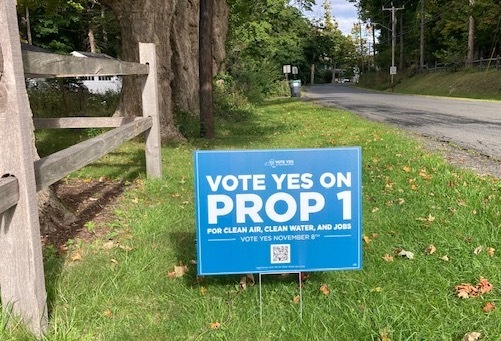

“Eating organic is nice, but if your goal is to save the climate, your vote is much more important.” −Natasja Van Gestel, soil ecologist.
In 1985, scientists discovered a big hole in the ozone layer over Antarctica. This was bad. Everyone was worried. I stopped using Aqua Net hair spray, and President Reagan signed the U.N. Montreal Protocol, banning the industrial use of ozone-depleting CFC chemicals, despite considerable industry pushback.
Oh the glory days, back when politicians were beholden to their constituents, rather than corporate greenbacks. Today, you’d be hard pressed to find a Republican politician anywhere who isn’t voting against policies that help fight climate change.
While the politicians are locking horns over our collective fate down in Washington, out here on Eastern Long Island, we take our environment seriously. Especially our water. We may have big differences, but when it comes to protecting our natural resources, folks in District 1 tend to rise above the national clamor of partisan politics.
When you vote this November (when not if), no matter what other boxes you check, there are two things you can do for the East End:
The first is to turn over the ballot and approve the Environmental Bond Act. Technically called the “The Clean Water, Clean Air, and Green Jobs Environmental Bond Act,” it’s a game changer.
With up to $4.2 billion in funding to modernize aging water infrastructure, protect open land and family farms, increase renewable energy production, improve public health and safety, and create good jobs, it’s the biggest investment in the environment in New York State history.
As Julie Tighe of The League Of Conservation Voters says, “We haven’t had an investment in the environment like this since … ever.”
The biggest infusion of funding ($1.5 billion) goes to climate change mitigation, including energy efficiency and renewable energy projects and upgrading aging stormwater infrastructure. It supports green building projects and programs to reduce carbon and methane pollution in agriculture.
Another $1.1 billion is dedicated to flood risk reduction and infrastructure upgrades. These funds will help implement coastal rehabilitation, waterfront revitalization, and wetland and habitat restoration. They’ll also help alleviate flooding with projects such as redesigning culverts so that the roads above them don’t blow out during increasingly bigger storms.
In order to address nitrogen pollution in the bays and aquifer (our only source of drinking water), there’s money for replacing failing septic tanks with more eco-friendly systems and establishing sewer lines.
The Environmental Bond Act also provides funding to preserve 30,000 acres of undeveloped land on Long Island for open space and wildlife habitat. It funds programs to improve the health of soil and conserves farmland, including creating and upgrading fish hatcheries.
It will support over 84,000 good paying, permanent jobs and initiate $8.7 billion in project spending. It’s endorsed by everyone from the General Contractors Association to the Council of Carpenters, plus a coalition of nearly 300 business, labor and civic groups that wouldn’t normally be considered “green.”
“For years government has been setting regulations and telling people what they have to do without giving them the resources to do it. Now we’re being given a hand with a big pot of money,” says Tighe.
So $4.2 billion sounds really expensive, right? When a policy expert assured me that it was “four times more of an infusion than anything that’s been done before,” I had this queasy feeling that it would raise taxes. But because it’s already part of the New York State budget, there’s no tax increase associated with the measure.
It’s also cost-effective because it builds on what’s recently been federally allocated for green infrastructure.
“The money in the bond act can leverage federal funding and bring more money to state projects,” says Jessica Ottney Mahar of The Nature Conservancy.
What will cost us money is not approving it. In 2020, climate-related disasters like hurricanes, droughts and wildfires cost the United States nearly $100 billion in damages to businesses, property and infrastructure, compared with an average of $18 billion a year in the 1980s. And as a coastal community, vulnerable to sea level rise, flooding, heat waves, beach erosion and water pollution, we take an especially hard hit. Given the steep price of dragging our feet, addressing climate change now is just sound economic policy.
The second way to protect our environment is Bridget Fleming. She’s running for Congress in District 1, is a serious climate champion and is in a very tight race.
Fleming has been fighting to protect the environment on the East End long before it became front page news, first on the Southampton Town Board in 2010 and, since 2015, as Suffolk County legislator.
Some people think Fleming is a little bit middle of the road. And that’s her gift. More workhorse than Twitter shouter, she crosses aisles, builds bridges and takes off her partisan hat on a regular basis. She joined with Republicans to pass 10 balanced budgets and hold the line on taxes and will work with anyone, anywhere on the spectrum, so long as they’re working to protect the environment.
Fleming says, “When you live on 1,000 miles of coastline, it’s about preserving a way of life, not who’s Democrat and who’s Republican.”
When faced with the monumentally thorny task of securing federal funding for Long Island, she doesn’t just pack up her toys and go home. She fights. She’s secured hundreds of millions of dollars in funding for clean water infrastructure and coastal protection. Working to combat the nitrogen pollution, she pushed through the first wastewater reform in over 30 years in order to upgrade septic systems. In Congress she’ll work to secure grants for things like solar rooftops, electric vehicles and septic upgrades. And she’ll work to make sure they don’t get taxed.
Fleming’s opponent, Nicholas J. LaLota never mentions the environment or clean water anywhere on his website. That’s unusual for a politician who wants to represent a part of the world where so much of the economy depends on a healthy environment. But to be fair, it’s hard to expect him to care about red tides and beach closures when he doesn’t live in District 1.
If you don’t normally vote in midterm elections, please do. Whether Democrat or Republican, vote for Bridget Fleming. Or at least get out to the polls for the Environmental Bond Act. Because as evangelical Christian and climate scientist Katherine Hayhoe points out in her book “Saving Us,” “A thermometer doesn’t give you a different answer depending on how you vote.”
 More Posts from Jenny Noble
More Posts from Jenny Noble